Paddy Rice Double-Cropping Field Monitoring via Vegetation Indices with Limited Ground Data—A Case Study for Thapanzeik Dam Irrigation District in Myanmar
Abstract
1. Introduction
2. Materials and Methods
2.1. Study Area
2.2. Data Utilized
2.3. Analysis Method
- (a)
- Investigation of current agricultural practices.
- (b)
- Impact of precipitation on crop growth.
- (c)
- NDVI and EVI performance assessment.
3. Results and Discussion
3.1. Agricultural Practices
3.2. Impact of Precipitation
3.3. Characteristics of NDVI and EVI
4. Conclusions
Author Contributions
Funding
Institutional Review Board Statement
Data Availability Statement
Acknowledgments
Conflicts of Interest
References
- Tasumi, M.; Hirakawa, K.; Hasegawa, N.; Nishiwaki, A.; Kimura, R. Application of MODIS Land Products to Assessment of Land Degradation of Alpine Rangeland in Northern India with Limited Ground-Based Information. Remote Sens. 2014, 6, 9260–9276. [Google Scholar] [CrossRef]
- Tucker, C.J. Red and photographic infrared linear combinations for monitoring vegetation. Remote Sens. Environ. 1979, 8, 127–150. [Google Scholar] [CrossRef]
- Wardlow, B.D.; Egbert, S.L. Large-area crop mapping using time-series MODIS 250 m NDVI data: An assessment for the U.S. Central Great Plains. Remote Sens. Environ. 2008, 112, 1096–1116. [Google Scholar] [CrossRef]
- Pervez, M.S.; Budde, M.; Rowland, J. Mapping irrigated areas in Afghanistan over the past decade using MODIS NDVI. Remote Sens. Environ. 2014, 149, 155–165. [Google Scholar] [CrossRef]
- French, A.N.; Hunsaker, D.J.; Sanchez, C.A.; Saber, M.; Gonzalez, J.R.; Anderson, R. Satellite-based NDVI crop coefficients and evapotranspiration with eddy covariance validation for multiple durum wheat fields in the US Southwest. Agric. Water Manag. 2020, 239, 106266. [Google Scholar] [CrossRef]
- Lai, Y.R.; Pringle, M.J.; Kopittke, P.M.; Menzies, N.W.; Orton, T.G.; Dang, Y.P. An empirical model for prediction of wheat yield, using time-integrated Landsat NDVI. Int. J. Appl. Earth Obs. Geoinf. 2018, 72, 99–108. [Google Scholar] [CrossRef]
- Panek, E.; Gozdowski, D. Analysis of relationship between cereal yield and NDVI for selected regions of Central Europe based on MODIS satellite data. Remote Sens. Appl. Soc. Environ. 2020, 17, 100286. [Google Scholar] [CrossRef]
- Son, N.T.; Chen, C.F.; Chen, C.R.; Minh, V.Q.; Trung, N.H. A comparative analysis of multitemporal MODIS EVI and NDVI data for large-scale rice yield estimation. Agric. For. Meteorol. 2014, 197, 52–64. [Google Scholar] [CrossRef]
- Huete, A.R. A Soil-Adjusted Vegetation Index (SAVI). Remote Sens. Environ. 1988, 25, 295–309. [Google Scholar] [CrossRef]
- Huete, A.; Didan, K.; Miura, T.; Rodriguez, E.P.; Gao, X.; Ferreira, L.G. Overview of the radiometric and biophysical performance of the MODIS vegetation indices. Remote Sens. Environ. 2002, 83, 195–213. [Google Scholar] [CrossRef]
- Bolton, D.K.; Friedl, M.A. Forecasting crop yield using remotely sensed vegetation indices and crop phenology metrics. Agric. For. Meteorol. 2013, 173, 74–84. [Google Scholar] [CrossRef]
- de Souza, C.H.W.; Mercante, E.; Johann, J.A.; Lamparelli, R.A.C.; Uribe-Opazo, M.A. Mapping and discrimination of soya bean and corn crops using spectro-temporal profiles of vegetation indices. Int. J. Remote Sens. 2015, 36, 1809–1824. [Google Scholar] [CrossRef]
- Petersen, L.K. Real-Time Prediction of Crop Yields From MODIS Relative Vegetation Health: A Continent-Wide Analysis of Africa. Remote Sens. 2018, 10, 1726. [Google Scholar] [CrossRef]
- JICA; SCI. Preparatory Survey on Agriculture Income Improvement Project in the Republic of the Union of Myanmar Final Report; Japan International Cooperation Agency and Sanyu Consultants Inc.: Tokyo, Japan, 2018; 414p, Available online: https://libopac.jica.go.jp/images/report/12306882.pdf (accessed on 28 December 2022).
- Didan, K.; Munoz, A.B. MODIS Vegetation Index User’s Guide (MOD13 Series); Vegetation Index and Phenology Lab, The University of Arizona: Tucson, AZ, USA, 2019. Available online: https://lpdaac.usgs.gov/documents/621/MOD13_User_Guide_V61.pdf (accessed on 28 December 2022).
- Wali, E.; Tasumi, M.; Moriyama, M. Combination of Linear Regression Lines to Understand the Response of Sentinel-1 Dual Polarization SAR Data with Crop Phenology-Case Study in Miyazaki, Japan. Remote Sens. 2000, 12, 189. [Google Scholar] [CrossRef]
- Huete, A.; Justice, C.; van Leeuwen, W. MODIS Vegetation Index (MOD 13) Algorithm Theoretical Basis Document Version 3, 1999, Online Document. Available online: https://modis.gsfc.nasa.gov/data/atbd/atbd_mod13.pdf (accessed on 28 December 2022).
- Ajith, K.; Geethalakshmi, V.; Ragunath, K.P.; Pazhanivelan, S.; Dheebakaran, G. Rice Yield Prediction Using MODIS-NDVI (MOD13Q1) and Land Based Observations. Int. J. Curr. Microbiol. App. Sci. 2017, 6, 2277–2293. [Google Scholar] [CrossRef]
- Johnson, D.M.; Rosales, A.; Mueller, R.; Reynolds, C.; Frantz, R.; Anyamba, A.; Pak, E.; Tucker, C. USA Crop Yield Estimation with MODIS NDVI: Are Remotely Sensed Models Better than Simple Trend Analyses? Remote Sens. 2021, 13, 4227. [Google Scholar] [CrossRef]
- Panek, E.; Gozdowski, D. Relationship between MODIS Derived NDVI and Yield of Cereals for Selected European Countries. Agronomy 2021, 11, 340. [Google Scholar] [CrossRef]
- Belton, B.; Win, M.T.; Zhang, X.; Filipski, M. The rapid rise of agricultural mechanization in Myanmar. Food Policy 2021, 101, 102095. [Google Scholar] [CrossRef]
- Nakata, T.; Tasumi, M.; Mitsuda, Y. Relationships among solar radiation, temperature, precipitation, and cloud cover in Kyushu and Okinawa. J. Rainwater Catchment Syst. 2023. in printing. [Google Scholar]
- Nishihama, M.; Wolfe, R.; Solomon, D.; Patt, F.; Blanchette, J.; Fleig, A.; Masuoka, E. MODIS Level 1A Earth Location: Algorithm Theoretical Basis Document Version 3.0. SDST-092; NASA Goddard Space Flight Centre: Greenbelt, MD, USA, 1997; 147p. [Google Scholar]




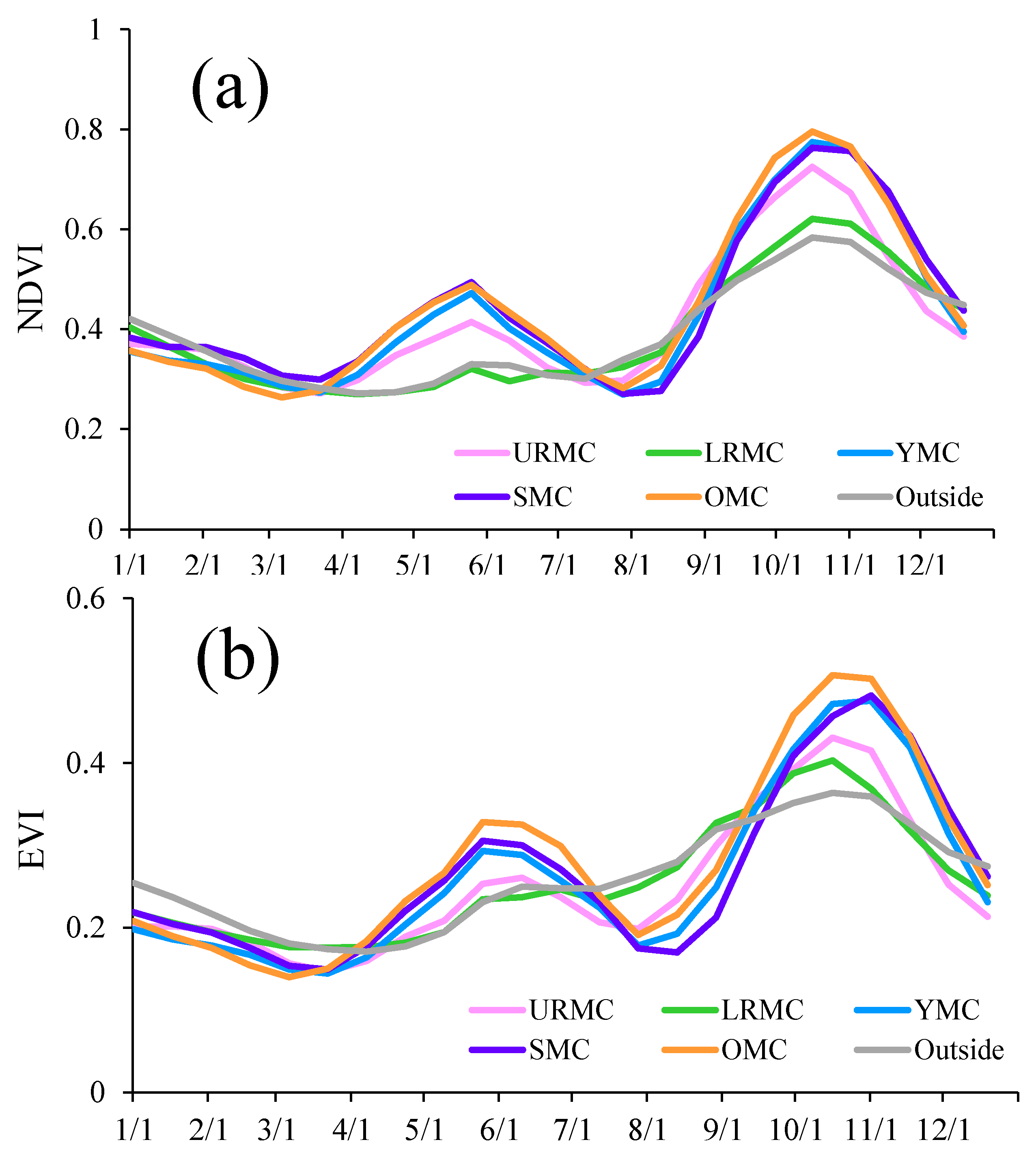


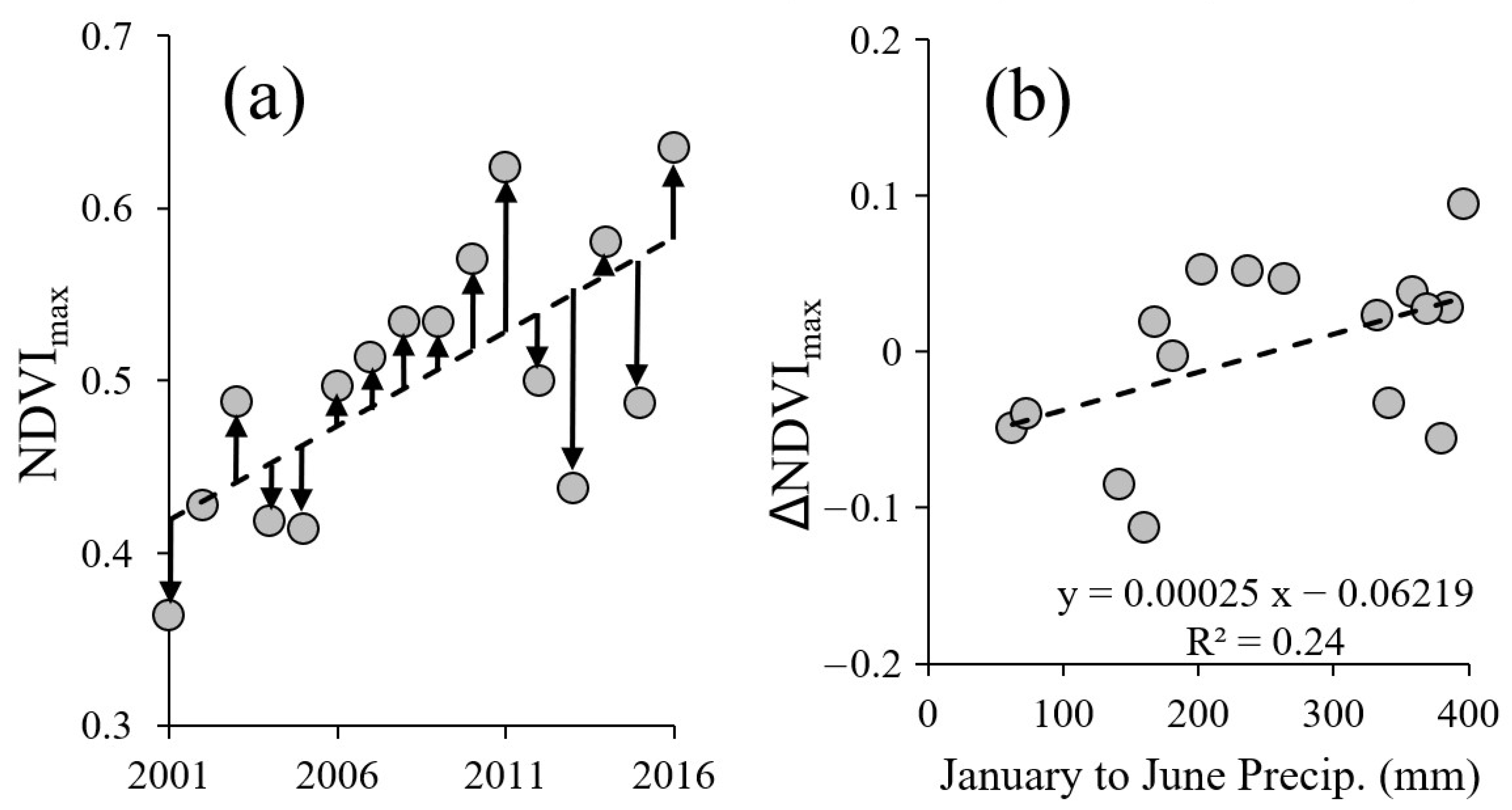

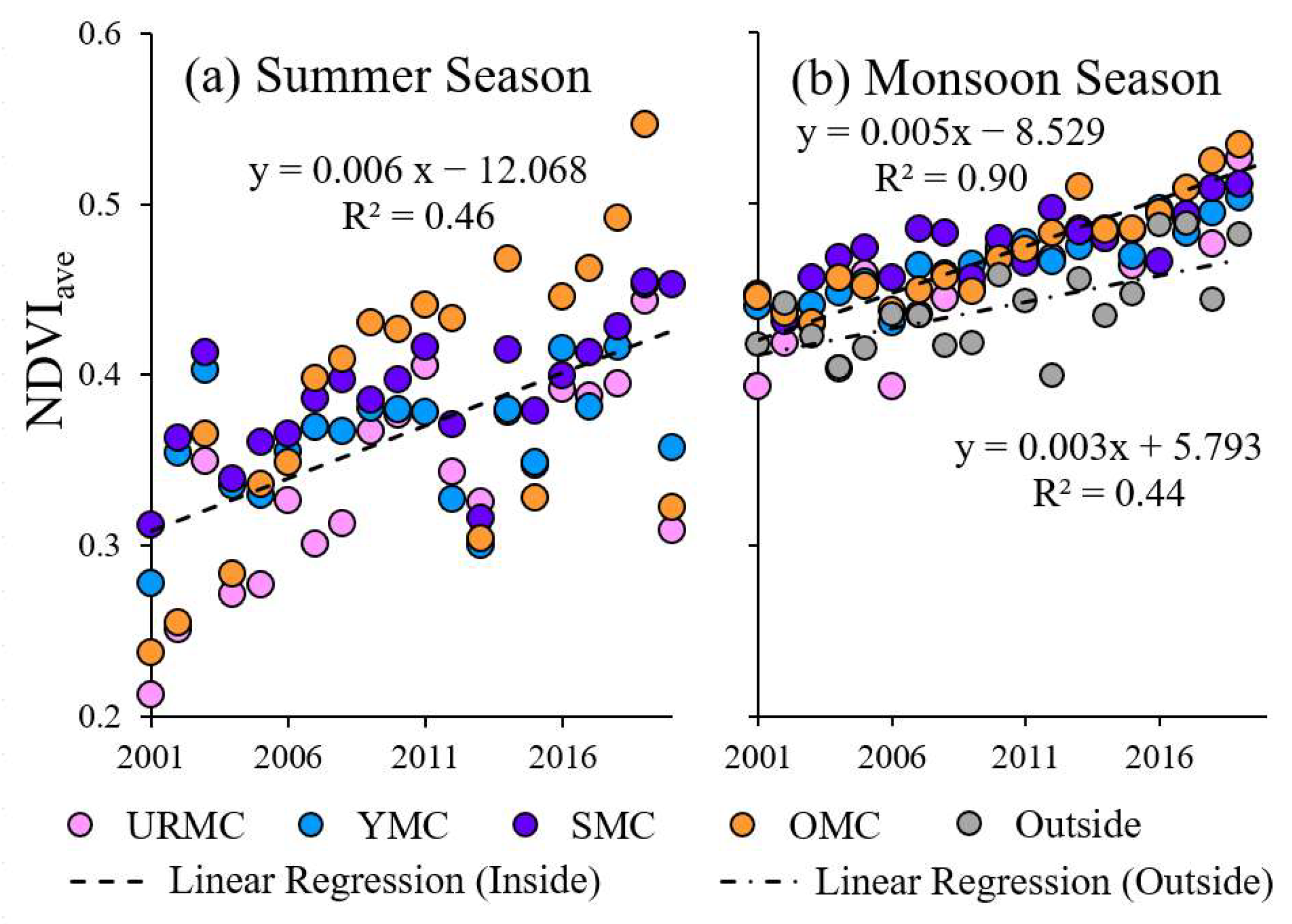

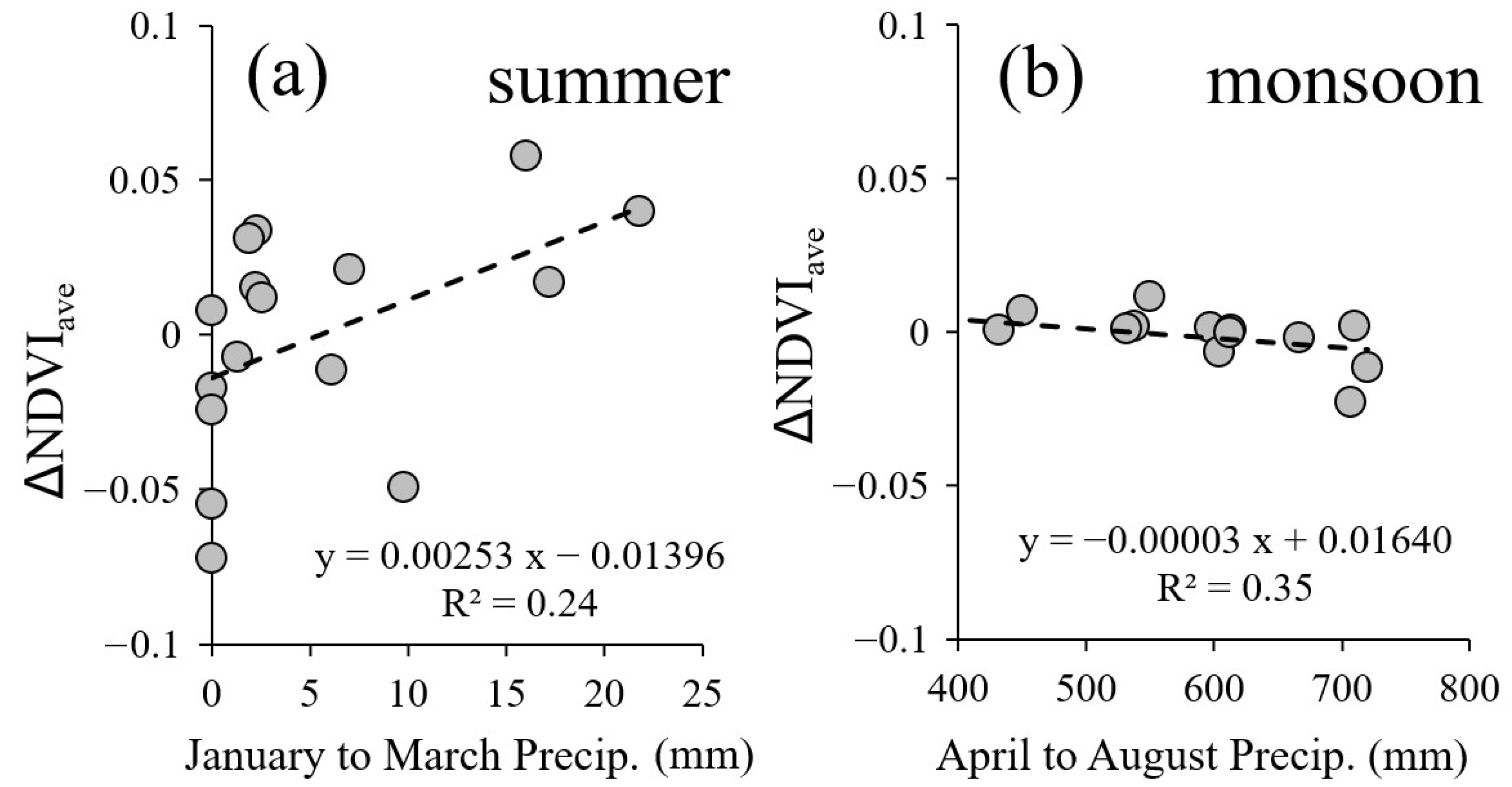
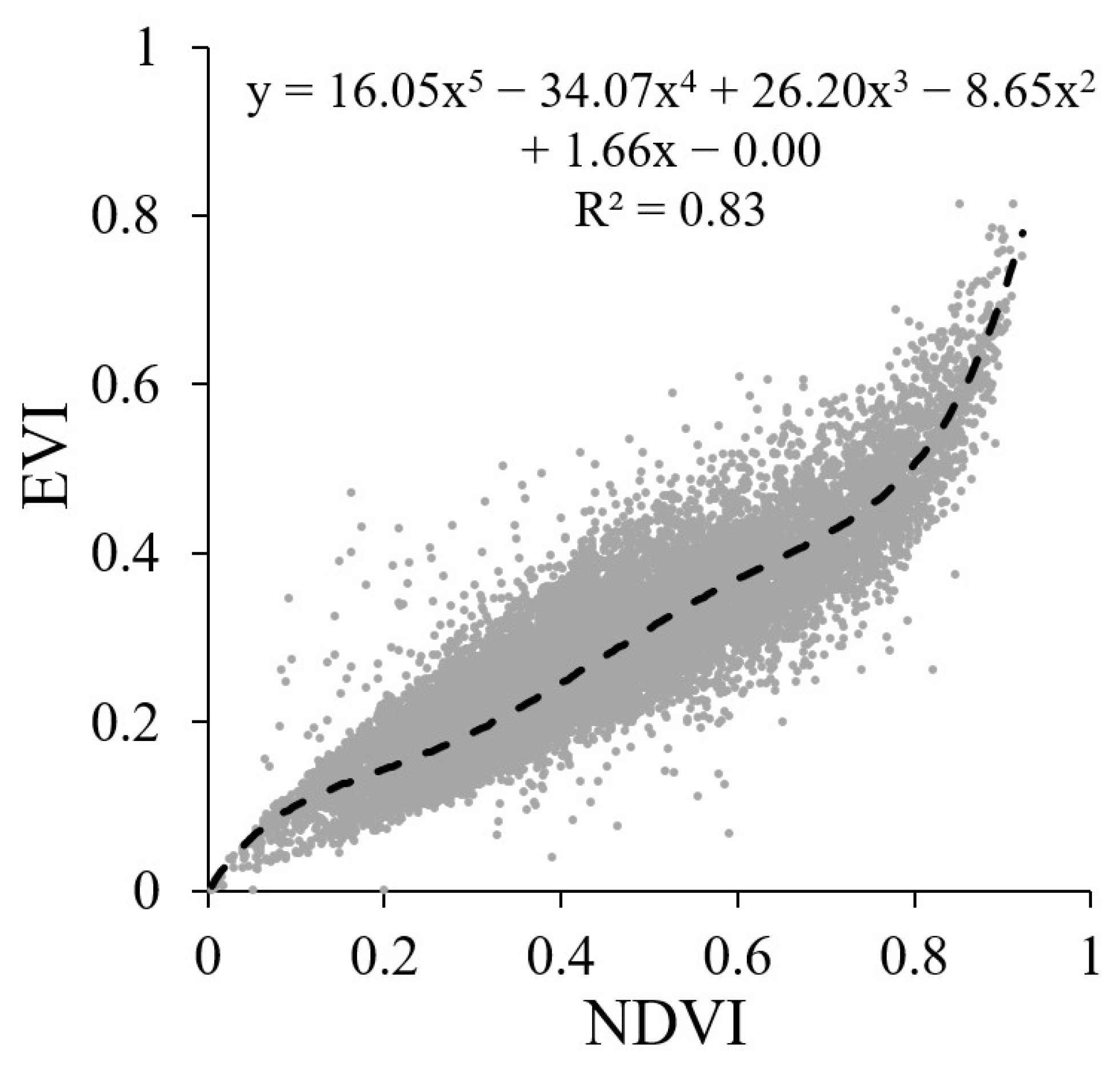

Disclaimer/Publisher’s Note: The statements, opinions and data contained in all publications are solely those of the individual author(s) and contributor(s) and not of MDPI and/or the editor(s). MDPI and/or the editor(s) disclaim responsibility for any injury to people or property resulting from any ideas, methods, instructions or products referred to in the content. |
© 2023 by the authors. Licensee MDPI, Basel, Switzerland. This article is an open access article distributed under the terms and conditions of the Creative Commons Attribution (CC BY) license (https://creativecommons.org/licenses/by/4.0/).
Share and Cite
Eguchi, T.; Tasumi, M. Paddy Rice Double-Cropping Field Monitoring via Vegetation Indices with Limited Ground Data—A Case Study for Thapanzeik Dam Irrigation District in Myanmar. Agriculture 2023, 13, 851. https://doi.org/10.3390/agriculture13040851
Eguchi T, Tasumi M. Paddy Rice Double-Cropping Field Monitoring via Vegetation Indices with Limited Ground Data—A Case Study for Thapanzeik Dam Irrigation District in Myanmar. Agriculture. 2023; 13(4):851. https://doi.org/10.3390/agriculture13040851
Chicago/Turabian StyleEguchi, Taketo, and Masahiro Tasumi. 2023. "Paddy Rice Double-Cropping Field Monitoring via Vegetation Indices with Limited Ground Data—A Case Study for Thapanzeik Dam Irrigation District in Myanmar" Agriculture 13, no. 4: 851. https://doi.org/10.3390/agriculture13040851
APA StyleEguchi, T., & Tasumi, M. (2023). Paddy Rice Double-Cropping Field Monitoring via Vegetation Indices with Limited Ground Data—A Case Study for Thapanzeik Dam Irrigation District in Myanmar. Agriculture, 13(4), 851. https://doi.org/10.3390/agriculture13040851




